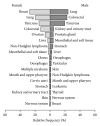Safety of Intravenous Application of Mistletoe (Viscum album L.) Preparations in Oncology: An Observational Study
- PMID: 24955100
- PMCID: PMC4052504
- DOI: 10.1155/2014/236310
Safety of Intravenous Application of Mistletoe (Viscum album L.) Preparations in Oncology: An Observational Study
Abstract
Background. Traditional mistletoe therapy in cancer patients involves subcutaneous applications of Viscum album L. preparations, with doses slowly increasing based on patient responses. Intravenous infusion of high doses may improve therapeutic outcomes and is becoming more common. Little is known about the safety of this "off-label" application of mistletoe. Methods. An observational study was performed within the Network Oncology. Treatment with intravenous mistletoe applications is described. The frequency of adverse drug reactions (ADRs) to intravenous mistletoe applications was calculated and compared to ADR data from a study on subcutaneous applications. Results. Of 475 cancer patients who received intravenous infusions of Helixor, Abnoba viscum, or Iscador mistletoe preparations, 22 patients (4.6%) reported 32 ADRs of mild (59.4%) or moderate severity (40.6%). No serious ADRs occurred. ADRs were more frequently reported to i.v. mistletoe administered alone (4.3%), versus prior to chemotherapy (1.6%). ADR frequency differed with respect to preparation type, with Iscador preparations showing a higher relative frequency, compared to Abnoba viscum and Helixor. Overall, patients were almost two times less likely to experience an ADR to intravenous compared to subcutaneous application of mistletoe. Conclusion. Intravenous mistletoe therapy was found to be safe and prospective studies for efficacy are recommended.
Figures


Similar articles
-
Use and safety of intratumoral application of European mistletoe (Viscum album L) preparations in Oncology.Integr Cancer Ther. 2015 Mar;14(2):140-8. doi: 10.1177/1534735414563977. Epub 2014 Dec 30. Integr Cancer Ther. 2015. PMID: 25552476
-
Adverse Drug Reactions and Expected Effects to Therapy with Subcutaneous Mistletoe Extracts (Viscum album L.) in Cancer Patients.Evid Based Complement Alternat Med. 2014;2014:724258. doi: 10.1155/2014/724258. Epub 2014 Jan 19. Evid Based Complement Alternat Med. 2014. PMID: 24672577 Free PMC article.
-
Immune-related and adverse drug reactions to low versus high initial doses of Viscum album L. in cancer patients.Phytomedicine. 2017 Dec 1;36:54-58. doi: 10.1016/j.phymed.2017.09.004. Epub 2017 Sep 21. Phytomedicine. 2017. PMID: 29157828
-
Immune modulation using mistletoe (Viscum album L.) extracts Iscador.Arzneimittelforschung. 2006 Jun;56(6A):508-15. doi: 10.1055/s-0031-1296818. Arzneimittelforschung. 2006. PMID: 16927532 Review.
-
[Mistletoe (Viscum album) preparations: an optional drug for cancer patients?].Harefuah. 2006 Jan;145(1):42-6, 77. Harefuah. 2006. PMID: 16450726 Review. Hebrew.
Cited by
-
Anthroposophic Medicine: A Short Monograph and Narrative Review-Foundations, Essential Characteristics, Scientific Basis, Safety, Effectiveness and Misconceptions.Glob Adv Health Med. 2020 Dec 29;9:2164956120973634. doi: 10.1177/2164956120973634. eCollection 2020. Glob Adv Health Med. 2020. PMID: 33457106 Free PMC article.
-
Complete remission and long-term survival of a patient with melanoma metastases treated with high-dose fever-inducing Viscum album extract: A case report.Medicine (Baltimore). 2017 Nov;96(46):e8731. doi: 10.1097/MD.0000000000008731. Medicine (Baltimore). 2017. PMID: 29145317 Free PMC article.
-
Clinical Safety of Combined Targeted and Viscum album L. Therapy in Oncological Patients.Medicines (Basel). 2018 Sep 6;5(3):100. doi: 10.3390/medicines5030100. Medicines (Basel). 2018. PMID: 30200590 Free PMC article.
-
Safety of Combined Treatment With Monoclonal Antibodies and Viscum album L Preparations.Integr Cancer Ther. 2018 Mar;17(1):41-51. doi: 10.1177/1534735416681641. Epub 2016 Dec 1. Integr Cancer Ther. 2018. PMID: 29444603 Free PMC article.
-
Safety of Anthroposophic Medicinal Products: An Analysis of Adverse Drug Reactions from German Pharmacovigilance Databases.Drugs Real World Outcomes. 2021 Dec;8(4):589-601. doi: 10.1007/s40801-021-00262-7. Epub 2021 Jul 28. Drugs Real World Outcomes. 2021. PMID: 34322827 Free PMC article.
References
-
- Orange M, Fonseca M, Lace A, von Laue HB, Geider S. Durable tumour responses following primary high dose induction with mistletoe extracts: two case reports. European Journal of Integrative Medicine. 2010;2(2):63–69.
-
- Huber R, Barth H, Schmitt-Gräff A, Klein R. Hypereosinophilia induced by high-dose intratumoral and peritumoral mistletoe application to a patient with pancreatic carcinoma. Journal of Alternative and Complementary Medicine. 2000;6(4):305–310. - PubMed
-
- Schad F, Axtner J, Buchwald D, et al. Intratumoral mistletoe (Viscum album L) therapy in patients with unresectable pancreas carcinoma: a retrospective analysis. Integrative Cancer Therapies. 2013 - PubMed
LinkOut - more resources
Full Text Sources
Other Literature Sources
Research Materials

